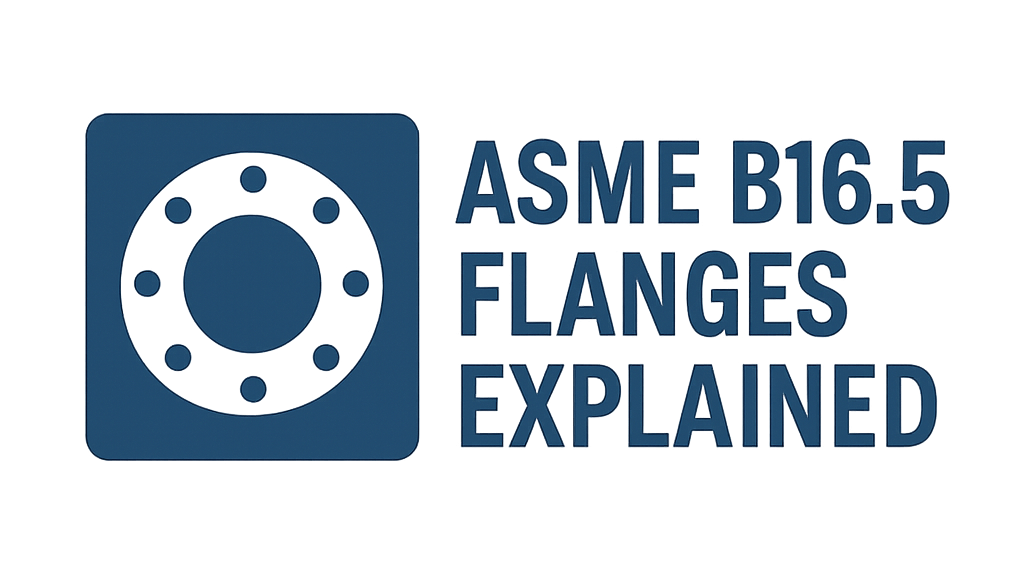ASME B16.5: Pipe Flanges and Flanged Fittings
A Guide to North American Standard Flanges
Understanding ASME B16.5
ASME B16.5 is a cornerstone standard from the American Society of Mechanical Engineers (ASME) that covers Pipe Flanges and Flanged Fittings for sizes NPS ½ through NPS 24 (Nominal Pipe Size). It specifies dimensions, tolerances, materials, pressure-temperature ratings, marking, and testing for flanges and flanged fittings. This standard is extensively used in the United States and many other parts of the world, particularly in industries such as oil and gas, petrochemical, power generation, and chemical processing.
Its primary purpose is to ensure safety, reliability, and interchangeability of these critical piping components.
Key Flange Types in ASME B16.5
The standard defines several common flange types, each designed for specific service conditions.
Weld Neck
Preferred for high-stress applications, high pressure, or extreme temperatures. The tapered hub provides excellent stress distribution.
Slip-On
Easier to align than Weld Necks but have lower strength. Welded at both hub and bore. Suitable for lower pressure applications.
Socket Weld
Used for smaller pipe sizes in high-pressure service. Pipe is inserted into a socket and fillet welded. Good flow characteristics.
Threaded (Screwed)
Used where welding is not practical or in highly explosive areas. Typically for lower pressure services.
Lap Joint
Used with a lap joint stub end. Allows for easy bolt alignment and is good for systems requiring frequent dismantling.
Blind
Used to seal the end of a piping system or vessel opening. Subjected to full system pressure.
Pressure Classes
ASME B16.5 defines seven pressure classes for flanges: Class 150, 300, 400, 600, 900, 1500, and 2500. These classes indicate the pressure-temperature rating of the flange. A higher class number means the flange can withstand higher pressures at a given temperature. The actual allowable pressure decreases as the operating temperature increases.
| Pressure Class | General Pressure Capability Level | Typical Service |
|---|---|---|
| Class 150 | Low Pressure | Water, low-pressure steam, general utilities |
| Class 300 | Medium Pressure | Oil, gas, chemical, general industrial |
| Class 400 | Medium-High Pressure | More demanding industrial applications |
| Class 600 | High Pressure | Oil and gas processing, power plants |
| Class 900 | Very High Pressure | Severe service, high-pressure pipelines, specialized processing |
| Class 1500 | ||
| Class 2500 |
Pressure-temperature ratings for specific material groups are detailed in tables within the ASME B16.5 standard.
Flange Facing Types
The facing is the surface of the flange that contacts the gasket. Common types in ASME B16.5 include:
Raised Face (RF)
Most common type. A small raised portion concentrates gasket pressure. Height is typically 1/16″ for Classes 150 & 300, and 1/4″ for higher classes.
Flat Face (FF)
Full contact surface. Used with full-face gaskets, often for Class 125/150 cast iron flanges or when mating to non-metallic flanges.
Ring-Type Joint (RTJ)
Machined grooves house a metallic ring gasket (oval or octagonal). Used for high-pressure, high-temperature critical services requiring a very reliable seal.
Tongue-and-Groove (T&G)
Mating flanges with corresponding tongue and groove. Ensures excellent gasket alignment and containment.
Male-and-Female (M&F)
One flange has a recessed area (female), the other a corresponding raised area (male). Offers good gasket retention and alignment.
Materials & Marking
Common Materials
ASME B16.5 flanges are made from various materials, primarily based on ASTM specifications:
- Carbon Steels: e.g., ASTM A105 (forgings for ambient and higher-temperature service).
- Stainless Steels: e.g., ASTM A182 Grade F304/304L, F316/316L (forgings for corrosive or high-temperature service).
- Alloy Steels: e.g., ASTM A182 Grade F11, F22, F5, F9 (forgings for high-temperature service).
- Low-Temperature Carbon Steels: e.g., ASTM A350 Grade LF2 (forgings for low-temperature service).
Standard Marking Requirements
Markings on ASME B16.5 flanges are crucial for identification and include:
- Manufacturer’s name or trademark.
- Material specification (e.g., A105, A182 F316).
- Pressure Class designation (e.g., 150, 300, CL150).
- Nominal Pipe Size (NPS).
- Flange type (e.g., WN, SO, BLD).
- Heat number or code for traceability.
- ASME B16.5 designation (may be implied by other markings).
Typical Pressure Class Usage in Projects
This chart shows an illustrative distribution of how frequently different ASME B16.5 pressure classes might be used across various industrial projects.
Note: Data is illustrative and based on general industry observations. Actual usage varies significantly by application.
Applications & Benefits
Typical Applications
ASME B16.5 flanges are integral to a wide array of industrial sectors:
Benefits of Standardization
Compliance with ASME B16.5 offers critical advantages:
-
🛡️
Enhanced Safety
Ensures flanges are designed and tested for specific pressure-temperature conditions, reducing failure risk.
-
🧩
Interchangeability
Flanges from different manufacturers meeting the standard can be reliably interchanged.
-
🌍
Global Acceptance & Simplified Procurement
Widely recognized standard simplifies design, specification, and sourcing of components globally.
Foundation of Piping Integrity
ASME B16.5 is a vital standard that underpins the safety and reliability of countless industrial piping systems worldwide. Its comprehensive specifications for flanges and flanged fittings ensure that these components can withstand demanding service conditions and integrate seamlessly. For engineers, designers, and operators, a thorough understanding and correct application of ASME B16.5 are paramount for ensuring the integrity and longevity of their installations.

